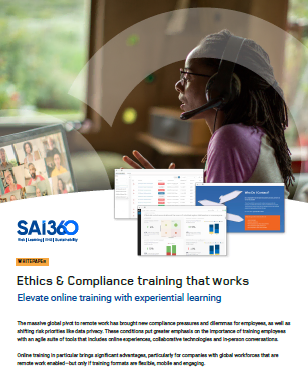3 Common Problems with Online E&C Training Modules
Don’t turn online E&C training into a mechanical tick-the-box exercise by forcing employees to sit through stale, passive learning modules.
The pandemic abruptly sped up the timeline for industry adoption of ethics and compliance support and training technologies. But warp-speed implementation of modern technologies doesn’t seem to have delivered a commensurate increase in the perceived value of E&C training programs. Responses from senior compliance officers in an SAI360 benchmark survey indicate there is still much work to be done on the training effectiveness front:
- 84% report they train employees with learning experiences that are not specific to the roles and responsibilities of each individual.
- 80% are not entirely confident their E&C programs are raising awareness and understanding of regulations and creating uniformity and standardization of work methods.
- Fewer than 35% believe that their programs manage risk more successfully.
Why do so many E&C professionals feel that their programs miss the mark? One reason is that companies often deliver online training in a manner that inadvertently creates barriers to effective learning.

Here are three common mistakes we see companies make when pivoting to online E&C training formats.
1. In-person workshops are converted to digital meeting platforms or video without consideration for online attention spans.
Learners who are presented with large chunks of one-way static content will only be able to follow attentively for a certain length of time when sitting in front of a computer screen. It’s important to keep online instructional elements short—especially now when employees with remote or hybrid work conditions are suffering acutely from screen fatigue. Videos, slide decks, frontal lectures and other linear media without interaction should not last longer than the average attention spans of online learners.
Something to keep in mind: not every training session has to take up a big block of 30 or 60 minutes. Sometimes you reap more interest and retention with a two-minute video or a five-minute quiz.
2. Training curriculum is delivered in a manner that tires and bores learners.
Learners lose interest when monotonously clicking through question-and-answer pages of identical format. And not everyone learns the same way, so online training material should alternate between different forms of media to support a diverse variety of learning styles.
A best-practice E&C training program blends games and simulations, videos, short five to ten-minute courses, and performance support tools.
It’s important to supplement phases of passive information intake with interactive modules that require learners to actively make decisions. Quizzes and simulations stimulate attention spans and help theoretical knowledge imprint powerfully through practical application.
Refreshers are a must, but presenting the exact same content again 1:1? That’s a no-go. Instead, introduce variations of the topic, present new problems within the same construct, or make changes to format layout and design. Even small modifications will help capture and retain the attention of learners.
3. Training scenarios don’t relate to day-to-day work experiences and situations.
A product manager in a startup is only slightly reflected in an outdated scenario about the HR manager of a public authority. To ensure that E&C training scenarios are relevant and authentic, they should be customized to the real-life roles, workflows, and tasks of the learners.
Package content in a story, so learners better identify with a scenario and its protagonists. Emotionally relating to the people involved and understanding their motives strengthens the bond with the scenario problem, which ultimately improves analysis and retention of the lessons.
Training on ethics and compliance content that supports your company culture and reinforces compliance with regulations doesn’t need to be a rote and unengaging learning experience that checks something off an employee’s to-do list. Incorporate Interesting tasks and compelling scenarios that generate self-motivation and spark conversations with colleagues. Gamification elements, such as self-tests that compare personal scores with the team average, can also help hold learners’ attention and solidify their understanding of the material.
The E&C Learning team at SAI360 has invested 25 years in the trenches helping organizations prepare for, respond to, and learn from ethics and compliances threats of all shapes and sizes. During that time, SAI360 has developed a proven (and award-winning) formula for highly effective and experiential E&C training programs. Modularity, variety, entertainment, and interaction are at the forefront of our approach.
Take a look for yourself by testing our learning formats in key risk areas including anti-bribery, code of conduct, and conflicts of interest.
E&C learning best practices whitepaper
 Ethics & Compliance Training that Works: Elevate Online Training with Experiential learning – Details about building E&C online training programs that are impactful and engaging.
Ethics & Compliance Training that Works: Elevate Online Training with Experiential learning – Details about building E&C online training programs that are impactful and engaging.
Learn about our comprehensive and customizable E&C Learning solutions. Or, contact us to see how we’ve helped organizations like yours.



